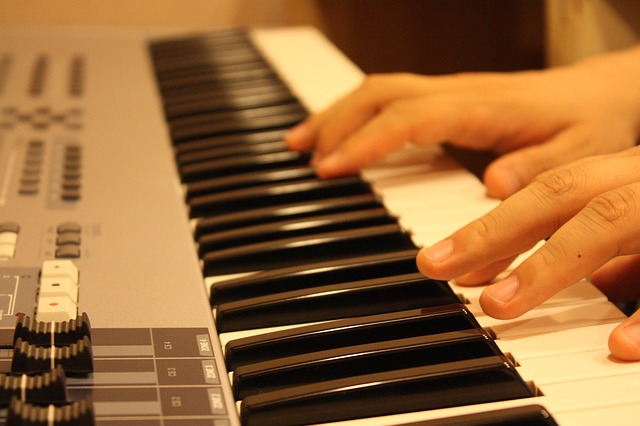A minor 6th chord on the piano isn’t what you would necessarily call an exotic chord. But you don’t often hear as much about those as you do extended chords such as 7ths, 9ths, 13ths, etc.
Today, I want to share with you a few concepts about using a minor 6th chord on the piano. I also I want to cover an interesting characteristic about the minor 6th chord that you may have never known about.
Let me give you a brief explanation of what constitutes a minor 6th chord using the key of C minor. (by the way, don’t let minor keys confuse you. I’ll explain as we go through the article)
The key of C minor…
The only difference in C Major and C minor is that the 3rd, 6th and 7th tones are lowered a half step.
All we need to do to build a C minor chord is to choose the root, minor third and fifth.
Even though this chord is minor, it’s based on a 6th interval of the key of C Major, so all we need to do is add the 6th to this minor chord. Find the 6th by counting up from the root. As you can see, the 6th in the key of C Major is A.
You now have a C minor 6 chord in root position.
Keep in mind that you can create any minor 6 chord with this formula…
…the F minor 6 chord
…the G minor 6 chord
Now that we’ve established the minor 6 chord, let’s talk about a few concepts on using them.
Let’s say that we have the standard 2-5-1 chord progression in the key of C Major.
…the 2 chord: D minor 7…
…the 5 chord: G7
…the 1 chord: C
You can substitute the 4 chord for the 5 chord. The 4 chord (F) is primarily a major chord.
However, you can choose to play a minor version of the F chord just by lowering the third from A to A flat.
You can find the 6th of F Major by counting up from the root.
You’ll then add the 6th tone of the F Major scale to the F Minor Chord. With the F minor 6 chord substituting for the G7 Chord, your progression would be ii-IV-I.


Play both of these progressions on your piano or keyboard and listen to how different it sounds. Remember that the first chord progression shown is a ii-V-I and the second chord progression is ii-IV-I.
Can you hear the difference that the 4 chord makes when you substitute it for the 5 chord? It has a much stronger pull to the 1 chord.
There’s a couple of reasons to explain this. One reason that this 4 chord has such a strong pull to the root is that you’re already playing a note that is in the C Major chord. Can you guess which one it is?
Of course, it’s C. The other two tones (F & D) are just a half step away from the ones they’re moving to. (G & E)
But that’s not the only unique characteristic about a minor 6 chord. It just so happens that there are two notes in this chord that have a very interesting relationship with one another.
If you haven’t already noticed, the minor 6 chord contains a tritone. You may have heard of the tritone substitution. That’s not exactly what this is, even though I am substituting one chord for another that actually has a tritone within it.
A tritone consists of two notes that are an interval of a minor 5th. An interval is the distance between two notes. You may have heard of a second, third, perfect fifth, etc. but the tritone is not traditionally discussed as much as the more common intervals that I just mentioned.
That doesn’t mean that the tritone is insignificant. It’s quite the opposite, because whether or not it’s played independently or within a chord, it produces a unique texture in music.
You can easily find a tritone based on any note or key in just three steps.
- Choose a note to build a tritone off of. (Let’s choose F)

- Choose the note that is a perfect 5th up. You can do this by simply counting up from the root.

You now have the interval of a perfect fifth. If you know your Major triads, you simply ask yourself: What is the fifth of an F Major Chord? The answer is obviously C. Learn your Major Chords and you’ll be rewarded for the rest of your musical life.Now take the 5th and lower a half step.

You now have the interval of a tritone.

You can verify that you have a tritone interval by counting the number of keys between both notes. There should be 5 keys between them.

Tritone intervals in other keys…


Play any one of these tritones on your piano or keyboard and you’ll hear that it’s an unstable interval. In other words, it doesn’t have a feeling of consonance or resolution such as the perfect 5th interval that I mentioned earlier. It actually has the feeling of needing to be resolved.
Now let’s take a look at the minor 6th chord that we covered earlier. Can you spot the tritone that exists within this chord?
If you chose the A flat and D, you’re absolutely correct!

The instability of the minor 6 chord is what creates such a strong resolution back to the 1 chord. The next time that you notice a 2-5-1 progression in one of your songs, substitute the 4 for the 5. It will absolutely redefine the progression you’re playing and add a professional touch as well freshen up a very standard progression that we hear so often.
I also want to point out that you don’t have to exclusively use the minor 6 chord as a substitution for a 5 chord. You can experiment with the minor 6 chord. For example, anywhere you have a primary chord, (which is a Major Chord by definition) try substituting the minor 6 chord. It won’t always fit but that’s why we experiment and discover concepts that are new to us.
Without getting into a lot of detail, you’re drawing from a parallel minor key when you are substituting a Major chord for a minor chord. But that’s another article for another day. Have fun with minor 6 chords and enjoy the difference they can make in your music.
Until next time, Go Play!
Greg Lee
Latest posts by Greg Lee (see all)
- What is a minor/Major 7 Chord? - October 26, 2023
- 7 Chord Substitutions that Professionals Use - October 19, 2023
- 5 Simple Chord Tricks to Sound Amazing - October 5, 2023





